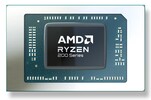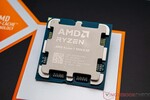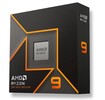AMD Ryzen 9 270 vs AMD Ryzen 7 9800X3D vs AMD Ryzen 9 9900X
AMD Ryzen 9 270
► remove from comparison
The Ryzen 9 270 is a rebadged Ryzen 9 8945HS, making it a fast mobile laptop processor. This is an APU of the Hawk Point family that has eight Zen 4 cores running at 4.0 GHz to 5.2 GHz. This APU was introduced at CES 2025 and all of its cores are SMT-enabled for a total of 16 processing threads.
Architecture and Features
Hawk Point family chips are powered by the Zen 4 architecture, much like Phoenix and Dragon Range family chips were. The 16 TOPS NPU present here isn't powerful enough for systems built around the 9 270 to be Copilot+ certified.
Elsewhere, the chip has 16 MB of L3 cache and support for super-fast DDR5-5600 and LPDDR5x-7500 RAM while also being compatible with USB 4 and thus with Thunderbolt. It comes with 20 PCIe 4 lanes, giving fast NVMe SSD up to 7.8 GB/s of throughput.
Please note that this processor is not overclockable and neither is it user-replaceable. It gets soldered to the motherboard for good instead (FP8 socket interface).
Performance
Its CPU performance is slated to be identical to the old Ryzen 9 8945HS and R9 7940HS.
Your mileage may vary depending on how high the CPU power limits are and how competent the cooling solution of your system is.
Graphics
The Radeon 780M has 12 CUs (768 shaders) purring away at up to 2,800 MHz. The Radeon will let you use up to 4 monitors with resolutions as high as SUHD 4320p and it will also HW-decode and HW-encode the most widely used video codecs (such as AV1, HEVC and AVC) without breaking a sweat. As for gaming, most 2024 games run fine at 1080p with settings set to Low on this graphics adapter.
Your mileage may vary depending on how high the CPU power limits are, how competent the cooling solution of the system is, how fast the RAM of the system is (there is no dedicated VRAM here).
Power consumption
This Ryzen 9 series chip has a long-term power limit (default TDP) of 35 W to 54 W, giving laptop makers a choice between longer battery life and higher performance. Either way, an active cooling solution is a must for a system powered by this chip.
The R9 270 is built with TSMC's 4 nm process for a reasonably good, as of early 2025, energy efficiency.
AMD Ryzen 7 9800X3D
► remove from comparison
Der AMD Ryzen 7 9800X3D ist ein High-End-Prozessor, der speziell für Gamer und anspruchsvolle Anwender entwickelt wurde. Er basiert auf der neuesten Zen-5-Architektur von AMD und wird im fortschrittlichen 4-nm-Verfahren gefertigt, was nicht nur höhere Effizienz, sondern auch eine bessere Leistung ermöglicht. Mit seinen 8 Kernen und 16 Threads bietet der 9800X3D eine solide Basis für rechenintensive Anwendungen.
Der größte Vorteil des AMD Ryzen 7 9800X3D ist die 3D V-Cache-Technologie, die komplett überarbeitet wurde und sich signifikant von den Modellen der 7000er-Serie unterscheidet. Die Änderungen resultieren in einer deutlich gesteigerten Taktfrequenz und einer besseren Wärmeverteilung. Der interne Aufbau besteht weiterhin aus einem I/O-Die sowie einem CCD. Letzterer beinhaltet die 8 Kerne sowie den 3D V-Cache und wird im 4nm-Prozess hergestellt. Beim I/O-Die hält AMD weiterhin am 6nm-Herstellungsprozess fest. Die Taktraten steigen im Vergleich zum Vorgängermodell spürbar. So beträgt der Basistakt 4,7 GH/z, wenngleich im Turbo bis zu 5,2 GH/s möglich sind.
Neben der überragenden Gaming-Performance überzeugt der AMD Ryzen 7 9800X3D auch in produktiven Anwendungen. Während er speziell auf Spieleoptimierung ausgelegt ist, schneidet er in Anwendungen wie 3D-Modellierung, Videobearbeitung und anderen kreativen Workloads spürbar besser ab als ein AMD Ryzen 7 7800X3D.
Die Leistungsaufnahme des AMD Ryzen 7 9800X3D beträgt 120 Watt, welche als PPT maximal 162 Watt beträgt. Damit gibt es in diesem Punkt keine Änderungen im Vergleich zum AMD Ryzen 7 7800X3D. Aufgrund gesteigerter Leistung kann die Effizienz des AMD Ryzen 7 9800X3D spürbar gesteigert werden. An die Effizienz der Arrow-Lake-Prozessoren kommt AMD allerdings trotz deutlich besserer Gaming-Leistung nicht heran.
Hier geht es zu unserem Test des AMD Ryzen 7 9800X3D.
AMD Ryzen 9 9900X
► remove from comparison
The Ryzen 9 9900X is fast desktop processor of the Granite Ridge product family that sports 12 Zen 5 cores (24 threads) running at 4.4 GHz to 5.6 GHz, PCIe 5 support and a basic RDNA 2 architecture iGPU. The Ryzen was launched in June 2024, with sales slated to start some time in August.
Architecture and Features
Like Strix Point APUs, Granite Ridge processors make use of the new Zen 5 microarchitecture. However, there are no efficient cores here; all of 9900X's cores are full Zen 5 cores. Furthermore, Granite Ridge is a multi-die design with only the CPU cores produced using a fairly modern 4 nm TSMC process. Strix Point processors are a single-die design, from what we know.
According to AMD, Zen 5 delivers a 16% IPC improvement over Zen 4 thanks to branch prediction improvements and other refinements.
Elsewhere, the 9900X has 64 MB of L3 cache and 24 direct PCIe 5 lanes (3.93 GB/s throughput per lane) with up to 12 additional PCIe 4 lanes available depending on the motherboard. It supports DDR5 RAM as fast as fast as 5,600 MT/s (up to 8,000 MT/s if overclocked).
The 9900X is unlocked for overclocking. Naturally, the AM5 socket CPU fully supports Windows 11, 64-bit Windows 10 as well as many Linux distros.
Performance
If early July leaks are any indication, the CPU delivers multi-thread performance on par with the AMD Ryzen 9 7950X and the Intel Core i7-14700K. We'll update this section once we get our hands on a system powered by the 9900X.
Graphics
The Radeon 610M comes equipped with just 128 unified shaders running at up to 2,200 MHz. Its gaming performance is slated to be extremely low and only just sufficient for pre-2020 games in resolutions such as 1024x768.
Power consumption
The CPU cores are built with TSMC's N4P process for good, as of mid 2024, power efficiency. (Apple is the leader in this regard with the second-generation 3 nm process.)
The Ryzen 7's long-term TDP is 120 W. It'll probably consume at least 170 W when under heavy short-term loads. If overclocked, the power consumption figures will increase significantly.
| Model | AMD Ryzen 9 270 | AMD Ryzen 7 9800X3D | AMD Ryzen 9 9900X | ||||||||||||||||||||||||||||||||||||||||||||||||||||||||||||||||||||||||||||||||||||||||||||||||||||||||
| Codename | Hawk Point-HS (Zen 4) | Granite Ridge | Granite Ridge | ||||||||||||||||||||||||||||||||||||||||||||||||||||||||||||||||||||||||||||||||||||||||||||||||||||||||
| Series | AMD Hawk Point (Zen 4/4c) | AMD Granite Ridge (Zen 5, AM5) | AMD Granite Ridge (Zen 5, AM5) | ||||||||||||||||||||||||||||||||||||||||||||||||||||||||||||||||||||||||||||||||||||||||||||||||||||||||
| Series: Granite Ridge (Zen 5, AM5) Granite Ridge |
|
|
| ||||||||||||||||||||||||||||||||||||||||||||||||||||||||||||||||||||||||||||||||||||||||||||||||||||||||
| Clock | 4000 - 5200 MHz | 4700 - 5200 MHz | 4400 - 5600 MHz | ||||||||||||||||||||||||||||||||||||||||||||||||||||||||||||||||||||||||||||||||||||||||||||||||||||||||
| L1 Cache | 512 KB | 640 KB | 768 KB | ||||||||||||||||||||||||||||||||||||||||||||||||||||||||||||||||||||||||||||||||||||||||||||||||||||||||
| L2 Cache | 8 MB | 8 MB | 12 MB | ||||||||||||||||||||||||||||||||||||||||||||||||||||||||||||||||||||||||||||||||||||||||||||||||||||||||
| L3 Cache | 16 MB | 96 MB | 64 MB | ||||||||||||||||||||||||||||||||||||||||||||||||||||||||||||||||||||||||||||||||||||||||||||||||||||||||
| Cores / Threads | 8 / 16 8 x 5.2 GHz AMD Zen 4 | 8 / 16 8 x 5.2 GHz AMD Zen 5 | 12 / 24 12 x 5.6 GHz AMD Zen 5 | ||||||||||||||||||||||||||||||||||||||||||||||||||||||||||||||||||||||||||||||||||||||||||||||||||||||||
| TDP | 45 Watt | 120 Watt | 120 Watt | ||||||||||||||||||||||||||||||||||||||||||||||||||||||||||||||||||||||||||||||||||||||||||||||||||||||||
| Technology | 4 nm | 4 nm | 4 nm & 6 nm | ||||||||||||||||||||||||||||||||||||||||||||||||||||||||||||||||||||||||||||||||||||||||||||||||||||||||
| Die Size | 178 mm2 | 192.6 mm2 | |||||||||||||||||||||||||||||||||||||||||||||||||||||||||||||||||||||||||||||||||||||||||||||||||||||||||
| max. Temp. | 100 °C | 95 °C | 95 °C | ||||||||||||||||||||||||||||||||||||||||||||||||||||||||||||||||||||||||||||||||||||||||||||||||||||||||
| Socket | FP8 | AM5 (LGA 1718) | AM5 | ||||||||||||||||||||||||||||||||||||||||||||||||||||||||||||||||||||||||||||||||||||||||||||||||||||||||
| Features | DDR5-5600/LPDDR5x-7500 RAM, PCIe 4, USB 4, Ryzen AI (16 TOPS), MMX, SSE, SSE2, SSE3, SSSE3, SSE4A, SSE4.1, SSE4.2, AVX, AVX2, AVX-512, BMI2, ABM, FMA, ADX, SMEP, SMAP, SMT, CPB, AES-NI, RDRAND, RDSEED, SHA, SME | DDR5-5600 RAM (incl. ECC), PCIe 5, MMX, SSE, SSE2, SSE3, SSSE3, SSE4.1, SSE4.2, SSE4A, AES, AVX, AVX2, AVX512, BMI1, BMI2, F16C, FMA3, EVP, SMAP, SMEP, SMT, SHA, XFR2 | DDR5-5600 RAM, PCIe 5 + PCIe 4, SMT, AES, AVX, AVX2, AVX512, FMA3, MMX (+), SHA, SSE, SSE2, SSE3, SSSE3, SSE4.1, SSE4.2, SSE4A | ||||||||||||||||||||||||||||||||||||||||||||||||||||||||||||||||||||||||||||||||||||||||||||||||||||||||
| iGPU | AMD Radeon 780M ( - 2800 MHz) | AMD Radeon 610M ( - 2200 MHz) | AMD Radeon 610M ( - 2200 MHz) | ||||||||||||||||||||||||||||||||||||||||||||||||||||||||||||||||||||||||||||||||||||||||||||||||||||||||
| Architecture | x86 | x86 | x86 | ||||||||||||||||||||||||||||||||||||||||||||||||||||||||||||||||||||||||||||||||||||||||||||||||||||||||
| Announced | |||||||||||||||||||||||||||||||||||||||||||||||||||||||||||||||||||||||||||||||||||||||||||||||||||||||||||
| Manufacturer | www.amd.com | www.amd.com | www.amd.com | ||||||||||||||||||||||||||||||||||||||||||||||||||||||||||||||||||||||||||||||||||||||||||||||||||||||||
| TDP Turbo PL2 | 162 Watt | ||||||||||||||||||||||||||||||||||||||||||||||||||||||||||||||||||||||||||||||||||||||||||||||||||||||||||
| Transistors | 9970 Million | ||||||||||||||||||||||||||||||||||||||||||||||||||||||||||||||||||||||||||||||||||||||||||||||||||||||||||
| Voltage | 1.28 - 1.31 (nominal), 1.4 (max) V | ||||||||||||||||||||||||||||||||||||||||||||||||||||||||||||||||||||||||||||||||||||||||||||||||||||||||||
| $479 U.S. |
Benchmarks
Average Benchmarks AMD Ryzen 9 270 → 100% n=2
Average Benchmarks AMD Ryzen 7 9800X3D → 138% n=2
Average Benchmarks AMD Ryzen 9 9900X → 149% n=2
* Smaller numbers mean a higher performance
1 This benchmark is not used for the average calculation













